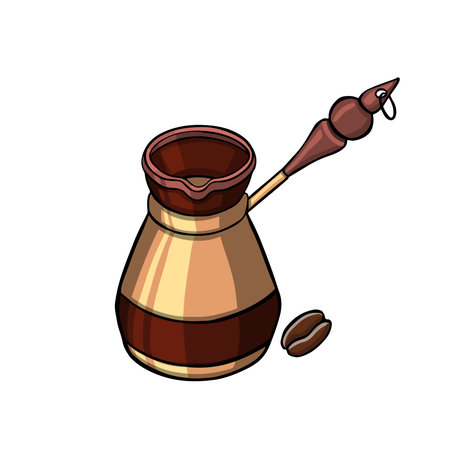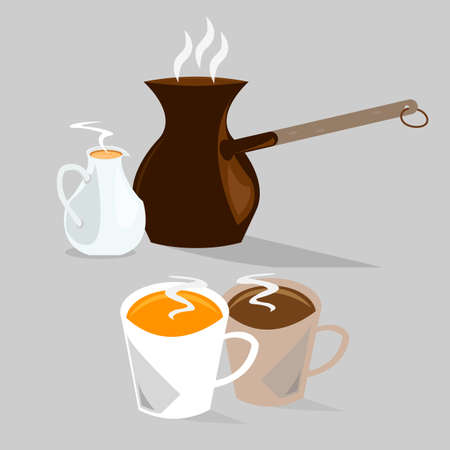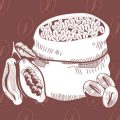Introduction to Mawa Pot and Kashmiri Coffee Culture
When we talk about the heartwarming beverages of India, it is impossible to overlook the rich tradition of Kashmiri coffee, lovingly prepared in the iconic Mawa Pot. Deeply rooted in the beautiful valleys of Kashmir, the Mawa Pot is not just a utensil—it is a symbol of togetherness, hospitality, and centuries-old customs. Unlike the typical chai enjoyed in most Indian households, Kashmiri coffee, or “Kahwa,” prepared in a Mawa Pot, stands out for its unique blend of flavors and cultural significance. In many Kashmiri homes, the ritual of brewing coffee in a Mawa Pot is closely tied to local celebrations such as weddings, festivals like Eid, and even during winter months when families gather around for warmth and stories. The aromatic notes of saffron, cardamom, and dry fruits fill the air, creating an ambiance that truly reflects the spirit of Kashmir. Beyond special occasions, the Mawa Pot finds its place in daily life as well—offering a comforting cup to guests or simply bringing family members together after a long day. This humble pot carries forward the legacy of Kashmiri hospitality and remains an essential part of local culture.
2. Unique Ingredients Used in Mawa Pot
The soul of Mawa Pot, the beloved Kashmiri coffee, lies in its exceptional and rich ingredients. Each component is thoughtfully chosen, reflecting both the local bounty of Kashmir and the deep-rooted traditions of Indian hospitality. Let us explore these unique elements and their cultural significance:
Saffron – The Golden Touch
No discussion about Kashmiri specialities can begin without mentioning saffron (kesar). Grown in the Pampore region, Kashmiri saffron is world-famous for its fragrance and vibrant colour. In Mawa Pot, a few precious strands are infused, imparting a golden hue and a distinct floral aroma that instantly reminds one of Indian festivities and celebrations.
Dry Fruits – Symbol of Abundance
Kashmir is also renowned for its variety of dry fruits. Almonds (badam), walnuts (akhrot), and pistachios (pista) are commonly added to Mawa Pot. These nuts not only enhance the richness but also symbolise prosperity and warmth, often served to guests as a mark of respect and care. Here’s a quick look at some typical dry fruits used:
| Dry Fruit | Kashmiri Name | Cultural Significance |
|---|---|---|
| Almonds | Badam | Represents health & hospitality |
| Walnuts | Akhrot | Symbolises prosperity |
| Pistachios | Pista | Signifies good fortune |
Mawa – Locally Sourced Milk Solids
The hero ingredient, mawa (also known as khoya), is made by slow-cooking milk until it thickens into solids. This ingredient gives Mawa Pot its creamy consistency and indulgent flavour. In India, mawa is considered pure and auspicious, frequently used during festivals like Diwali or Eid to prepare sweets. Using locally sourced mawa in this coffee brings not just taste but also a sense of community pride.
Why These Ingredients Matter?
Each ingredient in Mawa Pot is more than just a flavour enhancer—it carries with it centuries-old stories from Kashmiri households, moments of sharing between families, and festive gatherings where every sip is an expression of togetherness. Whether you are enjoying Mawa Pot on a chilly evening or serving it to your guests during special occasions, these ingredients bring alive the essence of Indian culture in every cup.

3. Step-by-Step Preparation Method
Gathering Ingredients and Utensils
To make authentic Kashmiri Mawa Pot coffee at home, start by assembling all the essentials. You will need freshly ground coffee powder (preferably locally sourced), full-cream milk, sugar or gur (jaggery) as per your taste, a pinch of saffron (kesar), cardamom (elaichi) pods, a handful of crushed almonds and pistachios, and the star ingredient – mawa or khoya. For utensils, Indian households often use a heavy-bottomed vessel (patila) and a long-handled ladle (chimta) for continuous stirring.
The Brewing Process
Step 1: Preparing the Milk Base
Pour full-cream milk into the patila and bring it to a gentle boil on low flame. Add the mawa/khoya and stir well till it dissolves completely, enriching the milk with a creamy texture. This process is crucial; patience is key here as slow simmering brings out the best flavour and consistency.
Step 2: Infusing Flavours
Add crushed cardamom pods and a few strands of saffron to the simmering mixture. These classic Indian spices not only provide an irresistible aroma but also lend warmth and subtle sweetness to your coffee. Let these infuse for a good 5-7 minutes on low flame.
Step 3: Adding Coffee & Sweetener
Stir in the coffee powder and sugar or jaggery as per your preference. Mix thoroughly to ensure there are no lumps. Continue simmering until the concoction thickens slightly, resembling rich Rabdi consistency often enjoyed during festivals in North India.
Step 4: Garnishing & Serving
Turn off the flame and add chopped dry fruits for that quintessential royal touch. Pour the Mawa Pot into small kulhad cups or steel tumblers, just like in traditional Kashmiri homes. Serve piping hot, especially during chilly evenings – it is truly a soul-soothing beverage!
Indian Kitchen Tips:
- Always keep stirring while boiling milk to avoid sticking at the bottom.
- If you wish for extra richness, add a small dollop of malai (milk cream) before serving.
- For those who prefer less sweetness, jaggery gives depth without being overpowering.
This step-by-step method mirrors how Indian families prepare their Mawa Pot, making each cup infused with tradition, warmth, and love.
4. Kashmiri Serving Style and Rituals
Kashmiri hospitality is known for its warmth and unique traditions, especially when it comes to serving beverages like the Mawa Pot coffee. In Kashmir, serving coffee is more than just a refreshment; it is a symbol of respect, love, and togetherness. Here, we explore the traditional ways to serve Mawa Pot and the meaningful customs that surround this cherished drink.
The Role of the Samovar in Kashmiri Coffee Culture
The iconic samovar, a beautifully crafted metal kettle, is central to Kashmiri coffee preparation and serving. Traditionally made from copper or brass with intricate designs, the samovar keeps the coffee warm throughout gatherings. The use of a samovar not only preserves the authentic flavour but also adds a touch of elegance to every occasion.
Traditional Serving Steps
| Step | Description |
|---|---|
| 1. Pre-warming Cups | Small ceramic or metal cups are pre-warmed to enhance the aroma and taste of Mawa Pot. |
| 2. Pouring from Samovar | Coffee is gently poured from the samovar spout into cups, maintaining its warmth. |
| 3. Garnishing | A sprinkle of crushed dry fruits or saffron is often added for extra flavour and fragrance. |
| 4. Sharing with Guests | The host personally serves each guest, signifying respect and affection. |
Local Customs & Etiquette
Kashmiris take great pride in their coffee rituals. When guests arrive, offering them Mawa Pot is considered a must-do gesture of hospitality—no gathering feels complete without it! It’s common for friends and family to sit in a circle, sharing stories while sipping slowly from their cups. Refilling cups multiple times shows generosity, and refusing a refill politely signals contentment rather than disrespect.
Cultural Insights:
- Bismillah: Before taking the first sip, many people say “Bismillah,” expressing gratitude.
- Sherbet Sharing: Sometimes, sweet treats or dried fruits are shared alongside Mawa Pot for an even richer experience.
- Respect for Elders: Elders are always served first as a mark of honour in traditional Kashmiri homes.
Serving Mawa Pot in Kashmir is not just about quenching thirst—it’s a soulful tradition that brings everyone closer, reflecting the essence of Indian unity and hospitality at its best.
5. Health Benefits and Ayurvedic Perspective
When we talk about the wellness aspect of Mawa Pot, it is not just a delightful beverage but also a comforting home remedy passed down through Kashmiri households. According to Indian tradition, every ingredient in the Mawa Pot recipe carries its own health benefits, blending taste with nourishment. Let’s explore how this aromatic Kashmiri coffee aligns with both Indian home remedies and Ayurveda.
Mawa Pot Ingredients: Wellness at Home
The key ingredients such as milk, saffron (kesar), cardamom (elaichi), and dry fruits like almonds and pistachios are familiar faces in every Indian kitchen. Milk serves as a natural coolant and is rich in calcium, while saffron is renowned for its warming properties, often recommended during winters to boost immunity and uplift mood. Cardamom aids digestion and gives relief from acidity—something our grandmothers always swore by after heavy meals. The dry fruits add a good dose of protein and healthy fats, nourishing the body from within.
Ayurvedic Wisdom: Balancing Doshas
From an Ayurvedic perspective, Mawa Pot is considered ‘satvik’—pure and balanced. Saffron and cardamom balance the Vata and Kapha doshas, making it suitable for most body types. The richness of milk pacifies Pitta, calming the mind and body. Often enjoyed during winter or chilly evenings, this drink helps maintain warmth and energy levels, which is why elders recommend it as a post-dinner treat or when feeling under the weather.
Home Remedy Touch: Everyday Healing
In many Indian homes, Mawa Pot is lovingly prepared for those recovering from illness or needing extra care. It’s believed that this Kashmiri coffee soothes sore throats, provides comfort against colds, and acts as a gentle energizer after long days. With every cup of Mawa Pot, you’re not only indulging in a royal taste but also embracing age-old Indian wisdom for wellbeing—truly embodying the spirit of “food as medicine.”
6. Mawa Pot in Modern Indian Homes
As India’s cities buzz with new trends and rural life continues to cherish age-old customs, the Mawa Pot has found its own unique place in both worlds. In urban homes, especially among millennials and young professionals, this traditional Kashmiri coffee is becoming a stylish drink to serve at house parties or family gatherings. Many cafés in metros like Delhi, Mumbai, and Bengaluru now offer a modern take on the classic recipe, adding flavours such as cardamom, rose petals, or even a hint of saffron for that extra zing. On the other hand, rural families still stick to the original preparation, using brass or copper pots and slow-brewing the coffee just like their ancestors did. Yet even here, you’ll find some desi twists: locals might add jaggery instead of sugar or use buffalo milk for a richer taste. Across India, whether it’s a chilly winter morning in Srinagar or a rainy evening in Pune, people love gathering around for a cup of Mawa Pot—bonding over tradition while embracing new flavours. This beautiful blend of old and new is what keeps the spirit of Kashmiri coffee alive in today’s diverse Indian households.

